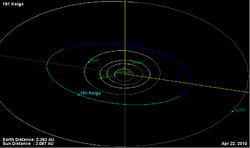Astronomy:191 Kolga
From HandWiki
 Orbital diagram | |
| Discovery | |
|---|---|
| Discovered by | C. H. F. Peters |
| Discovery date | 30 September 1878 |
| Designations | |
| (191) Kolga | |
| Pronunciation | /ˈkɒlɡə/ |
| Named after | Kólga |
| Minor planet category | Main belt |
| Orbital characteristics[1] | |
| Epoch 31 July 2016 (JD 2457600.5) | |
| Uncertainty parameter 0 | |
| Observation arc | 131.26 yr (47942 d) |
| |{{{apsis}}}|helion}} | 3.1588 astronomical unit|AU (472.55 Gm) |
| |{{{apsis}}}|helion}} | 2.6313 AU (393.64 Gm) |
| 2.8951 AU (433.10 Gm) | |
| Eccentricity | 0.091106 |
| Orbital period | 4.93 yr (1799.2 d) |
| Mean anomaly | 326.28° |
| Mean motion | 0° 12m 0.288s / day |
| Inclination | 11.508° |
| Longitude of ascending node | 159.31° |
| 227.00° | |
| Earth MOID | 1.64648 AU (246.310 Gm) |
| Jupiter MOID | 2.29413 AU (343.197 Gm) |
| TJupiter | 3.253 |
| Physical characteristics | |
| Dimensions | (134.3±12.8)×(78.2±1.7) km[2] |
| Mean radius | 50.515±1.75 km |
| Rotation period | 17.625 hours[3] 17.604 h (0.7335 d)[1] |
| Geometric albedo | 0.0408±0.003 |
| Absolute magnitude (H) | 9.07 |
191 Kolga (minor planet designation: 191 Kolga) is a large, dark main-belt asteroid that was discovered by German-American astronomer C. H. F. Peters on September 30, 1878, in Clinton, New York. It is named after Kólga, the daughter of Ægir in Norse mythology.[4]
In 2009, Photometric observations of this asteroid were made at the Palmer Divide Observatory in Colorado Springs, Colorado. The resulting light curve shows a synodic rotation period of 17.625 ± 0.004 hours with a brightness variation of 0.30 ± 0.03 in magnitude. Previous independent studies produced inconsistent results that differ from this finding.[3]
References
- ↑ 1.0 1.1 Yeomans, Donald K., "191 Kolga", JPL Small-Body Database Browser (NASA Jet Propulsion Laboratory), https://ssd.jpl.nasa.gov/sbdb.cgi?sstr=191, retrieved 6 May 2016.
- ↑ P. Maley; T. George; J. Bardecker; T. Blank; D. Dunham; D. Kenyon; J. Gout; M. Collins et al. (9 February 2018), Stellar occultation from 191 Kolga (preliminary analysis), http://www.asteroidoccultation.com/observations/Results/Data2018/20180209_KolgaProfileAligned.gif, retrieved 3 October 2018
- ↑ 3.0 3.1 Warner, Brian D. (October 2009), "Asteroid Lightcurve Analysis at the Palmer Divide Observatory: 2009 March-June", The Minor Planet Bulletin 36 (4): 172–176, doi:10.1016/j.pss.2012.03.009, Bibcode: 2009MPBu...36..172W.
- ↑ Schmadel, Lutz D. (2012), Dictionary of Minor Planet Names (6th ed.), Springer, p. 30, ISBN 978-3642297182, https://cds.cern.ch/record/1339660/files/978-3-540-29925-7_BookTOC.pdf.
External links
- Lightcurve plot of 191 Kolga, Palmer Divide Observatory, B. D. Warner (2009)
- Asteroid Lightcurve Database (LCDB), query form (info )
- Dictionary of Minor Planet Names, Google books
- Asteroids and comets rotation curves, CdR – Observatoire de Genève, Raoul Behrend
- Discovery Circumstances: Numbered Minor Planets (1)-(5000) – Minor Planet Center
- 191 Kolga at AstDyS-2, Asteroids—Dynamic Site
- 191 Kolga at the JPL Small-Body Database
 |

